Different Types of Smokehouses and Smokehouse Plans
This is an
excerpt
from a great homesteading book on home butchering of every description.
It is called "The
Complete Book of Butchering, Smoking, Curing and Sausage Making" by
Philip Hasheider, published by Voyageur Press. We
have a book
review of this book, and it comes highly recommended for
those of you
homesteading and wanting information on home butchering.
Below is an
excerpt from the book on smokehouses,
building a homemade smoker
and
the
equipment you need for home smoking.
A smokehouse is a simple version of a heat processing unit used by today's meat industry. The size may be vastly different, but the principles are the same: it is an enclosed area where the temperature and smoke level may be controlled with acceptable accuracy. If you decide to build a smokehouse, it does not need to be an elaborate structure to do an effective job. However, it must be adequately built and have the ability to be monitored so that the meat is properly cooked to minimize health risks.
The purpose of a smokehouse is to enclose heat and smoke, and reduce, but not entirely eliminate, airflow. Depending on how much smoking you want to accomplish, you may construct your own smokehouse or purchase a commercial unit. Because smokehouses are generally located outdoors, you should check if any local ordinances or fire codes apply before you begin construction of any new structures.
Many types of smokehouses can be used successfully to smoke meats, fowl and fish. Smokehouses can include simple equipment as a charcoal grill for very small amounts of meat, metal barrels, water and electric smokers, and in more extensive units, those of frame or concrete construction.
The more elaborate structures will cost more to build. By understanding your end goals, you can make a reasonable assessment of which type will work best for you. Depending on where you live, you may be able to get your smoke done with a local meat shop that smokes its products. The paragraphs below detail the different types of smokehouses to consider.
Separate the coals onto two sides of the grill and place a pan of water between them. Place the grate over the top and place your sausages above the water. As the sausages heat and cook, the fat will drip into the heated water and create steam that will help destroy harmful bacteria.
Keep the vents open on the cover. For hot smoking, you will need to maintain an air temperature between 225 to 300 degrees Fahrenheit throughout the process.
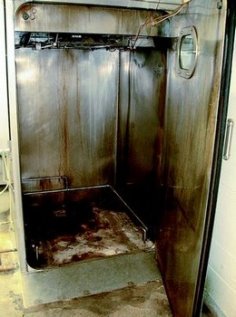 A
vertical water smoker is built with a bottom fire pan that holds
charcoal briquettes and generally has two cooking racks near the top.
A
vertical water smoker is built with a bottom fire pan that holds
charcoal briquettes and generally has two cooking racks near the top.
The water pan positioned above the coals supplies moisture and helps regulate that internal temperature. An electrical smoker is similarly constructed, except the smoke is controlled by pre-moistened wood chips rather than charcoal. This will provide a more constant temperature and may require less attention during smoking.
The sizes of electric smokers vary with some accommodating up to 40 pounds of sausages at one time.
Dig a pit at the lower end for the fire. Smoke rises naturally, so having the fire lower than the barrel will aid its movement towards the meats. Mound the dirt around the edges of the barrel and the fire pit to eliminate the leaks. You can control the heat by covering it with a piece of sheet metal.
Use metal or wood tubes as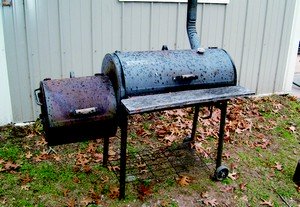 racks from which to suspend
your sausages in
the barrel. At the beginning of the smoking, you want a rapid flow of
air past the meat to drive off excessive moisture.
racks from which to suspend
your sausages in
the barrel. At the beginning of the smoking, you want a rapid flow of
air past the meat to drive off excessive moisture.
Less rapid air movement near the end of the smoking period prevents excessive shrinkage of meat. Use moist wood chips, sawdust, or charcoal for starting your fire.
You want a lot of smoke but very little flame. Once your fire is going, you can add green sawdust or green hardwood to cool the fire and make more smoke. Never use gasoline or other accelerants to start your fire. Besides their explosive potential, which can cause serious injury, the fumes and residues will contaminate your sausage.
Metal strips can be attached to the cover, to help hold it in place, trapping the smoke near the meat. You can monitor the inside temperature by suspending a thermometer from one of the metal racks.
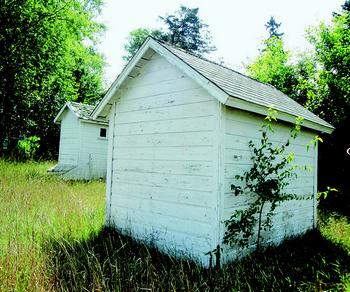 You can build a smokehouse out of
wood or
concrete blocks. While these are more elaborate structures, they will
accommodate larger quantities of meats at one time and will last for
many years.
You can build a smokehouse out of
wood or
concrete blocks. While these are more elaborate structures, they will
accommodate larger quantities of meats at one time and will last for
many years.
They have the advantage of making temperature control easier and reducing fire hazards.
Their tight construction and well-fitted ventilators can control air flow past the meat. A larger-size building will provide space for several tiers of racks. This will let you adjust the hangers to the size of the pieces of meat being smoked. Meats can be crowded into a smokehouse, but the only rule is that no piece of meat be able to touch another or the wall.
Any building you construct should have four features: a source of smoke, a place to hold the smoke, a method to hold the meat in the smoke, and a draft regulator near the top of bottom.
A smokehouse is a very slow oven in which the temperature does not exceed 200 degrees Fahrenheit. Even though you will use and maintain low temperatures, build your smoke house in a safe location from other buildings, particularly your home and away from all combustible materials. Check with local ordinances and fire codes, before you begin any construction.
A smokehouse is a simple version of a heat processing unit used by today's meat industry. The size may be vastly different, but the principles are the same: it is an enclosed area where the temperature and smoke level may be controlled with acceptable accuracy. If you decide to build a smokehouse, it does not need to be an elaborate structure to do an effective job. However, it must be adequately built and have the ability to be monitored so that the meat is properly cooked to minimize health risks.
The purpose of a smokehouse is to enclose heat and smoke, and reduce, but not entirely eliminate, airflow. Depending on how much smoking you want to accomplish, you may construct your own smokehouse or purchase a commercial unit. Because smokehouses are generally located outdoors, you should check if any local ordinances or fire codes apply before you begin construction of any new structures.
Many types of smokehouses can be used successfully to smoke meats, fowl and fish. Smokehouses can include simple equipment as a charcoal grill for very small amounts of meat, metal barrels, water and electric smokers, and in more extensive units, those of frame or concrete construction.
The more elaborate structures will cost more to build. By understanding your end goals, you can make a reasonable assessment of which type will work best for you. Depending on where you live, you may be able to get your smoke done with a local meat shop that smokes its products. The paragraphs below detail the different types of smokehouses to consider.
Charcoal Grill:
One of the least expensive methods to smoke small amounts of meats and sausages is on your covered charcoal grill. This will require an oven thermometer to monitor the temperature. You can fill the bottom of your grill with briquettes and burn them until gray ash appears.Separate the coals onto two sides of the grill and place a pan of water between them. Place the grate over the top and place your sausages above the water. As the sausages heat and cook, the fat will drip into the heated water and create steam that will help destroy harmful bacteria.
Keep the vents open on the cover. For hot smoking, you will need to maintain an air temperature between 225 to 300 degrees Fahrenheit throughout the process.
Vertical Water and Electrical Smokers:
 A
vertical water smoker is built with a bottom fire pan that holds
charcoal briquettes and generally has two cooking racks near the top.
A
vertical water smoker is built with a bottom fire pan that holds
charcoal briquettes and generally has two cooking racks near the top.
The water pan positioned above the coals supplies moisture and helps regulate that internal temperature. An electrical smoker is similarly constructed, except the smoke is controlled by pre-moistened wood chips rather than charcoal. This will provide a more constant temperature and may require less attention during smoking.
The sizes of electric smokers vary with some accommodating up to 40 pounds of sausages at one time.
Barrel Smoker:
A clean, non-contaminated 50-gallon metal barrel, with both ends removed, can be used as a smoker for small quantities of meat, fowl, and fish. Set the open-ended barrel on the upper end of a shallow, sloping, covered trench or 10-to12-foot stovepipe.Dig a pit at the lower end for the fire. Smoke rises naturally, so having the fire lower than the barrel will aid its movement towards the meats. Mound the dirt around the edges of the barrel and the fire pit to eliminate the leaks. You can control the heat by covering it with a piece of sheet metal.
Use metal or wood tubes as
 racks from which to suspend
your sausages in
the barrel. At the beginning of the smoking, you want a rapid flow of
air past the meat to drive off excessive moisture.
racks from which to suspend
your sausages in
the barrel. At the beginning of the smoking, you want a rapid flow of
air past the meat to drive off excessive moisture. Less rapid air movement near the end of the smoking period prevents excessive shrinkage of meat. Use moist wood chips, sawdust, or charcoal for starting your fire.
You want a lot of smoke but very little flame. Once your fire is going, you can add green sawdust or green hardwood to cool the fire and make more smoke. Never use gasoline or other accelerants to start your fire. Besides their explosive potential, which can cause serious injury, the fumes and residues will contaminate your sausage.
Metal strips can be attached to the cover, to help hold it in place, trapping the smoke near the meat. You can monitor the inside temperature by suspending a thermometer from one of the metal racks.
Frame or Concrete Smokehouse:
 You can build a smokehouse out of
wood or
concrete blocks. While these are more elaborate structures, they will
accommodate larger quantities of meats at one time and will last for
many years.
You can build a smokehouse out of
wood or
concrete blocks. While these are more elaborate structures, they will
accommodate larger quantities of meats at one time and will last for
many years. They have the advantage of making temperature control easier and reducing fire hazards.
Their tight construction and well-fitted ventilators can control air flow past the meat. A larger-size building will provide space for several tiers of racks. This will let you adjust the hangers to the size of the pieces of meat being smoked. Meats can be crowded into a smokehouse, but the only rule is that no piece of meat be able to touch another or the wall.
Any building you construct should have four features: a source of smoke, a place to hold the smoke, a method to hold the meat in the smoke, and a draft regulator near the top of bottom.
A smokehouse is a very slow oven in which the temperature does not exceed 200 degrees Fahrenheit. Even though you will use and maintain low temperatures, build your smoke house in a safe location from other buildings, particularly your home and away from all combustible materials. Check with local ordinances and fire codes, before you begin any construction.
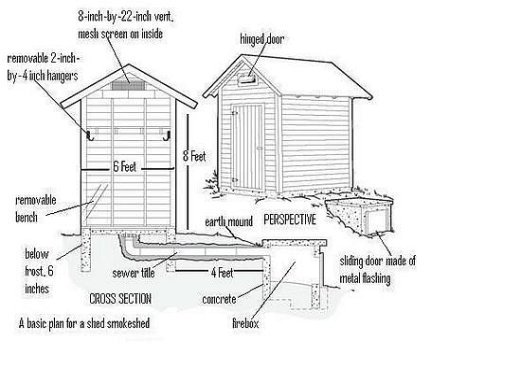 The size
of your smokehouse can be calculated based on the amounts and
weights of meat used. These requirements vary with the weight of the
cuts. To estimate the capacity of your smokehouse, use an accepted
measure of 12 inches in width, front and back, and 2 feet in height for
each row. Construction plans for smokehouses are generally available
from university extension offices or commercial supply companies.
The size
of your smokehouse can be calculated based on the amounts and
weights of meat used. These requirements vary with the weight of the
cuts. To estimate the capacity of your smokehouse, use an accepted
measure of 12 inches in width, front and back, and 2 feet in height for
each row. Construction plans for smokehouses are generally available
from university extension offices or commercial supply companies.While smokehouses are excellent for processing meats, they do not make a good storage area for smoke-finished meats. After your smoking processing is complete, flies will eventually get in either on a piece of meat or when the door is open. Smokehouses can be used for storage, however, if each piece of meat is properly wrapped, bagged, and hung separately, provided everything is fly and insect proof.
Smoking Pork
Smoking pork raises certain considerations. If you are smoking pork and want to eat it without further cooking, you smoke it to an internal temperature of 137 degrees Fahrenheit to make sure that you kill any trichinae, which are the cause of trichinosis. You can used a meat thermometer to check the temperature. The meat in the smokehouse is approximately 10 to 15 degrees less than the smokehouse air temperature. Raise the smokehouse temperature to 155 degrees, just to be safe.Dutch Ovens
A second advantage of using a Dutch oven is its versatility. Bread, roasts, and stews call all be cooked in it, making it an excellent camp utensil. Dutch ovens are easy to use and remove much of the uncertainty of cooking small game. Cooking in them does not require you to pay as close attention as in a regular home oven. Many models are available, and you should investigate which one may best suit your purposes.
Final Considerations
You may become enthused or enchanted by your smoking ability and like the flavors you create. However, do not replace your normal cooking procedures and dietary needs with this practice. Eating too much smoked meat can be a cause of some health concerns. The problems generally are found in the smoke, which contains coal tars that are considered carcinogenic. You may want to use your smoked meats as special treats rather than for daily meals.If you want
to know more about how to butcher your meat, how to smoke
sausages, bacon, poultry, beef and recipes that will give you the best
results, then you will just have to buy the book! How? Well click on
the book below and you can buy it directly from Amazon.com
If your curiosity has gotten the best of you and you would like to see another excerpt from this book on home butchering we have something else for you. Home butchering of sheep, lambs and goats from the same book above.
If your curiosity has gotten the best of you and you would like to see another excerpt from this book on home butchering we have something else for you. Home butchering of sheep, lambs and goats from the same book above.
Finally, we have smokehouse plans for you, for the
concrete smokehouse above.
Add your own Comments on Home Butchering or Smoking Meats Here!
We have lots of pages where you can contribute to throughout this homesteading website. We love hearing from our readers, and hope you will be one of those we hear from too. Do you have some of your own ideas on home butchering or smokehouses that you would like to share?Leave a Comment
Do you have anything that you would like to add after reading this page? We would love to hear your thoughts. If you can add additional information to what has been written here you will be adding value to the website! No need to have any special skills - just type and submit. We will do the rest!
Other Comments
Click below to see comments from other visitors to this page...
My Homemade Smoker 



I bought an old ice box a couple of years ago just to make a smoker.
I removed the wood racks for the ice and placed wire racks in their stead then …
Not as bad as your warning says. :) Not rated yet
http://en.wikipedia.org/wiki/Creosote
IF you are burning wood for the smoker it would contain wood-tar, not coal-tar. Which wood tar is way less toxic …



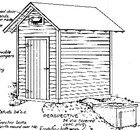

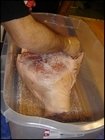
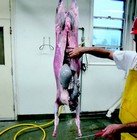
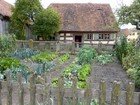
New! Comments
Do you have something of value to add? Leave me a comment in the box below.